K-Means Clustering
Learn K-Means Clustering, a key unsupervised learning algorithm for grouping data into clusters. Explore its process, applications, and comparisons!
K-Means Clustering is a widely used algorithm in the field of
unsupervised learning designed to partition a
dataset into distinct, non-overlapping subgroups. In the broader context of
machine learning (ML), this method is essential
for discovering hidden patterns and structures within unlabeled data. The algorithm operates by organizing data points
into $K$ number of clusters, where each point belongs to the cluster with the nearest mean, serving as a prototype of
the group. This approach helps in minimizing the variance within each cluster, ensuring that data points in the same
group are as similar as possible while keeping different groups distinct.
How the Algorithm Works
The process of K-Means is iterative and begins with the selection of $K$ initial centroids, which act as the center
points for the clusters. These centroids can be chosen randomly or via smarter initialization techniques like
k-means++ initialization
to improve convergence speed. The algorithm then proceeds through two primary steps until the results stabilize:
-
Assignment: Each data point in the
training data is assigned to the nearest centroid
based on a distance metric, typically the
Euclidean distance. This step effectively groups the
data into $K$ clusters.
-
Update: The new centroid for each cluster is calculated by computing the mean of all data points
assigned to that specific cluster.
This cycle repeats until the centroids no longer move significantly, indicating that the algorithm has converged.
Determining the optimal number of clusters is a critical part of the process, often achieved using techniques like the
Elbow method
or by analyzing the
Silhouette score
to measure separation distance between resulting clusters.
Real-World Applications in AI
K-Means Clustering is versatile and finds utility across various industries for
data mining and analysis tasks.
-
Customer Segmentation: Businesses utilize clustering to group customers based on purchasing
behavior, demographics, or browsing history. By identifying distinct groups, companies can tailor marketing
strategies, similar to how AI in retail improves
customer targeting and inventory management.
-
Image Compression: In the realm of
computer vision (CV), K-Means is employed for
color quantization. This technique reduces the number of unique colors in an image by clustering pixel values,
effectively performing
dimensionality reduction while
maintaining the visual integrity of the image.
-
Anomaly Detection: By learning the structure of normal data clusters, systems can identify outliers
that fall far from any centroid. This is valuable for security applications and
anomaly detection in network traffic.
K-Means in Object Detection History
While modern object detectors like Ultralytics YOLO11 often
utilize advanced regression techniques or anchor-free heads, K-Means played a pivotal role in the evolution of
detection models. Earlier iterations, such as YOLOv2 through YOLOv5, used K-Means clustering on the bounding box
dimensions of the COCO dataset to determine optimal
anchor boxes. These pre-calculated anchors provided
the model with better priors for predicting object shapes, significantly improving training stability and recall.
K-Means vs. K-Nearest Neighbors (KNN)
It is common to confuse K-Means with
K-Nearest Neighbors (KNN), but they serve
fundamentally different purposes.
-
K-Means is an unsupervised algorithm used for clustering. It does
not require labeled data and focuses on finding the inherent structure within the dataset.
-
KNN is a supervised learning algorithm used for
image classification and regression. It
relies on labeled input to classify new data points based on the majority class of their closest neighbors.
Another related concept is
DBSCAN, which clusters based on density rather than distance from a central point. Unlike K-Means, DBSCAN does not require
the number of clusters to be specified beforehand and is better at handling outliers.
Code Example: Color Quantization
The following Python example demonstrates how to use K-Means to cluster pixel colors, a common
data preprocessing step in vision tasks.
import numpy as np
from sklearn.cluster import KMeans
# Simulate a small image (10x10 pixels) with 3 RGB channels
# In a real scenario, you would load an image using cv2.imread()
image_data = np.random.randint(0, 255, (10, 10, 3), dtype=np.uint8)
pixels = image_data.reshape(-1, 3)
# Apply K-Means to reduce the image to 3 dominant colors (clusters)
kmeans = KMeans(n_clusters=3, n_init="auto", random_state=42).fit(pixels)
# The cluster centers represent the dominant colors
print(f"Dominant RGB Colors:\n{kmeans.cluster_centers_}")












